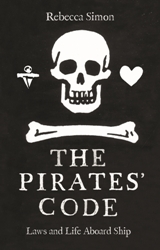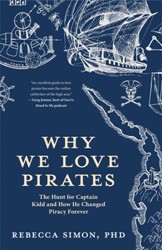 Pirates and Privateers Pirates and Privateers
The History of Maritime
Piracy
Cindy Vallar, Editor
& Reviewer
P.O. Box 425,
Keller, TX 76244-0425
    
Books for Adults ~ History: Piracy
The
Pirates' Code
Why We Love
Pirates

The Pirates’ Code: Laws and Life Aboard Ship
by Rebecca Simon
Reaktion, 2023, ISBN 978-1-78914-711-7, US $22.50 / UK
£15.99
    
Many people may
think of pirates as being somewhat chaotic
and in favor of anarchy. The opposite is
true, as Dr. Simon adeptly demonstrates in
her latest book, The Pirates’ Code.
Each crew of pirates devised their own set
of rules under which they would sail, and
these articles of agreement dictated what
would happen to anyone who failed to
adhere to them. Such codes also indicated
how much each pirate received from plunder
and how much compensation injured pirates
were entitled to. The pirates and their
codes under discussion here sailed during
the most prolific period of piracy, 1650
to 1730. The earliest mention of such an
agreement comes from Alexandre Exquemelin,
a buccaneer and the author of The
Buccaneers of America. Four other
articles of agreement have come down to
us. The first, which appeared in a
colonial newspaper and an account of
thirty-six men tried for piracy, belonged
to pirates who sailed with the infamous
Edward Low. The other three codes
(published in Captain Johnson’s A
General History of the Pyrates) were
from the crews of Bartholomew Roberts,
George Lowther, and John Phillips.
After introducing readers to the Golden
Age of Piracy and articles of agreement,
Dr. Simon divides the rules into
individual chapters in which she explores
the purpose of each and how it impacts a
pirate’s life. The first focuses on work
and wages on a pirate ship, providing some
comparisons to life in the merchant marine
and navy. The second examines punishments;
these pertain to both those the pirates
suffer when in violation of the rules and
what they inflict on captives. Chapter
three concerns health and safety, while
the fourth explores intimate relationships
among pirates (male and/or female).
Weaponry, fighting tactics, and safety are
covered in chapter five. The subjects of
food, drink, and vices are discussed in
the sixth and seventh chapters.
Entertainment and culture are explored in
the final one. She concludes her study of
the articles and pirate life with a look
at how the pirates bring about their own
downfall by the end of the era.
Black-and-white illustrations are
scattered throughout the book, which also
has a center section of color pictures.
There are a select list of pirates that
includes tidbits about each and a
glossary. References, a bibliography, and
an index round out the volume.
There are many books that focus on pirates
and their lives at sea, but Dr. Simon
brings a fresh perspective to this topic
by examining them from the lens of their
articles of agreement. She provides
snippets from contemporary documents and
eyewitnesses, be they pirates or victims,
to showcase how aspects of the rules
impacted what pirates did and how they
lived. Specific pirates, some well-known
and others who are not, are showcased to
validate what is discussed under each
rule. Throughout the book she
emphasizes that these codes served
specific purposes: to safeguard their
environment, to minimize conflict among
themselves, to maintain loyalty within
each crew, and to provide protection from
the hazards of working at sea. In other
words, the goals of these articles were to
gain wealth and stay alive.
The Pirates’ Code is informative,
refreshing, and remarkable. It shines a
light on a much-discussed topic while also
bringing forth new material not found in
previous books. Regardless of your level
of knowledge of pirate lore, this volume
is a treasure for any collection.
Review Copyright ©2023 Cindy Vallar


Why We Love Pirates: The Hunt for
Captain Kidd and How He Changed Piracy Forever
By Rebecca Simon
Mango, 2020, ISBN 978-1-64250-337-1, US $18.95
Have
you ever read a book that holds your attention
from beginning to end, but from time to time a
statement strikes you as odd or wrong or
leaves you wanting more clarification? Think
about this while I introduce this recent
addition to pirate lore.
Buried treasure. Eye patches. Peg legs.
Walking the plank. These are but a few of the
tropes we associate with pirates. Particularly
those of the golden age of piracy. For the
most part, these piratical associations are
fictional and stem from a late 19th-century
book – Treasure Island. So who were
the real sea bandits and what did people think
of them when they were most prevalent? How do
they differ from their pop culture image? Is
there one pirate, above all the rest, who most
influenced those who came after him?
Dr. Simon believes Captain William Kidd “is
responsible for pirates’ eternal fame in
popular culture.” (20) He was ruthless,
especially toward his own men, going so far as
to kill one of them for defying him. He was a
snappy dresser. He considered himself an
honest man who got a bum rap. His actions, the
worldwide manhunt he instigated, and the
plethora of publications and rumors of buried
treasure that he inspired serve as the
intertwining thread of Why We Love Pirates.
Simon’s goals are to investigate “piracy
through the lens of Captain Kidd’s pirate life
. . . discover exactly who pirates were and
why people chose this profession . . . uncover
the true story of Captain Kidd, and of how and
why the British government sought to
exterminate pirates at all costs . . . unbury
how exploding print industry influenced public
opinion about pirates and how cultural and
social norms of the era made us love pirates
so much. And . . . how their deaths gave them
permanent infamy.” (21-22)
She begins by showing the complexity of one
question: Who Were Pirates? This topic is not
as simple as black and white. It depends on
who was asked and what interaction they had,
if any, with these marauders, as well as the
historical events occurring at a specific time
and place. From there, she delves into Captain
Kidd, who he was, what he did, how he “became
a martyr for the pirate community,” and the
myths and legends that his exploits inspired.
(57) Chapter three discusses government
attempts to suppress piracy, as well as who
the pirates were who came after Kidd.
Subsequent chapters cover pirate codes,
relationships, executions, alcohol, fake news
and twisting facts to suit a purpose,
execution sermons and last words, and
portrayals in literature, film, and other
media. The book also includes a Timeline of
the Golden Age of Piracy, Cast of Characters,
maps, illustrations, bibliography, and
endnotes, but no index.
If you seek an introduction to the buccaneers
and the pirates who followed them, this is an
entertaining and engaging pirate history with
contemporary quotes to illustrate the
narrative. If you want to stimulate a lively
discussion, Why People Love Pirates
provides food for thought.
So why my opening question? There are several
reasons. Some of Simon’s statements come
across as facts when, in reality, they are
assumptions that cannot be proven one way or
the other. One example: she asserts that Anne
Bonny and Mary Read were gay. There’s no
historical proof of this. It’s a hypothesis
that some historians believe and others do
not. A few other sentences left me scratching
my head. For example, she writes that Stede
Bonnet “suffered a leg injury during his first
battle alongside Blackbeard and was lame for
the rest of his life.” (109) No other resource
I’ve read over the past twenty years mentions
this fact, and Simon doesn’t provide her
source for this information.
Another reason for my reservations pertains to
inaccurate statements, especially those
pertaining to Captain Kidd, the underlying
theme for this book. Most readers won’t pick
up on these, but those familiar with pirate
history will. Captain Kidd did not work for
the British East India Company, although his
commission to hunt pirates included those who
preyed on their ships and one of his financial
backers was the director of the New East India
Company. After Kidd attacked the Quedagh
Merchant, the book says that “as a
compromise [the crew] let some of the hostage
crew leave on the Adventure Galley.
The ship immediately set sail to England to
deliver the news.” (68) Kidd and his men
sailed Adventure Galley back to
Madagascar, where she was beached and burned
because she was no longer seaworthy. Nor was
he immediately arrested when he arrived in
Boston in1699. He got there on 1 July, heard
the Reverend Cotton Mather’s sermon on 2 July,
met with Lord Bellomont on 3 July, and was
finally taken prisoner on 6 July. His
commission did not allow him to attack Dutch
ships as stated on page 73; at the time,
England’s king was Dutch and the two countries
were allies. The commission gave Kidd the
authority to attack French ships, which is why
the passes he confiscated from the Quedagh
Merchant were so important for his
defense. Robert Culliford did not hang “for
being associated with Kidd.” (150) Culliford
got off scot-free after testifying against
another pirate and disappeared from the
historical record. Kidd was executed with one
of his men and two French pirates.
Still, Simon achieves the goals outlined in
her introduction. You may not agree with all
her conclusions, but she is persuasive and
spurs you to delve deeper into the real
history of pirates.
Review
Copyright ©2021
Cindy Vallar


Click to contact me
Background image compliments
of Anke's Graphics |


